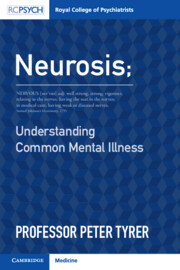Book contents
- Neurosis: Understanding Common Mental Illness
- Reviews
- Neurosis
- Copyright page
- Dedication
- Contents
- Figures
- Tables
- Foreword
- Acknowledgements
- Introduction
- Chapter 1 The General Neurotic Syndrome
- Chapter 2 DSM-III and the Generation of New Diagnoses
- Chapter 3 The Hypotheses of the Nottingham Study of Neurotic Disorder
- Chapter 4 Interpretation of the Results of the 1988 Lancet Randomised Trial
- Chapter 5 The Medium-Term Outcome of the General Neurotic Syndrome
- Chapter 6 The General Neurotic Syndrome at 12 Years
- Chapter 7 The Last Phase
- Chapter 8 Is the Notion of the General Neurotic Syndrome Useful?
- Appendix Personality Assessment Schedule (Tyrer & Alexander, 1979)
- References
- Index
Chapter 7 - The Last Phase
The General Neurotic Syndrome after 30 Years
Published online by Cambridge University Press: 29 September 2022
- Neurosis: Understanding Common Mental Illness
- Reviews
- Neurosis
- Copyright page
- Dedication
- Contents
- Figures
- Tables
- Foreword
- Acknowledgements
- Introduction
- Chapter 1 The General Neurotic Syndrome
- Chapter 2 DSM-III and the Generation of New Diagnoses
- Chapter 3 The Hypotheses of the Nottingham Study of Neurotic Disorder
- Chapter 4 Interpretation of the Results of the 1988 Lancet Randomised Trial
- Chapter 5 The Medium-Term Outcome of the General Neurotic Syndrome
- Chapter 6 The General Neurotic Syndrome at 12 Years
- Chapter 7 The Last Phase
- Chapter 8 Is the Notion of the General Neurotic Syndrome Useful?
- Appendix Personality Assessment Schedule (Tyrer & Alexander, 1979)
- References
- Index
Summary
It is never too late to do a long-term follow-up study. Through long-term follow-up, a full knowledge of tardive dyskinesia, a condition once thought to be permanent, has illustrated that this is far from the case (e.g., Cavallaro et al., 1993). But there is bound to be a loss of people to contact when you study follow-up at 30 years. The common word for this is attrition – ‘the gradual reduction in the number of people who are involved in a study that is achieved by not replacing those who leave’. I have always found this word to be a somewhat euphemistic one; the usual cause of attrition is death. In the case of cancer studies, death (mortality) is the primary outcome in most cases. With the general neurotic syndrome, early death is clearly an important outcome, but mental health at follow-up is more so. Following the advice of Sir Richard Doll (see Chapter 3), we decided at this point to choose the dichotomous outcome of the absence or presence of one of the main DSM diagnoses. The very minor diagnoses such as simple phobia and adjustment disorders were not included here.
- Type
- Chapter
- Information
- NeurosisUnderstanding Common Mental Illness, pp. 68 - 81Publisher: Cambridge University PressPrint publication year: 2022



